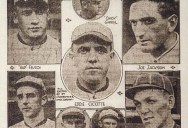This Day In History – August 3rd

CHRISTOPHER COLUMBUS EMBARKS ON MAIDEN VOYAGE IN SEARCH OF A WESTERN ROUTE TO THE EAST INDIES – AUGUST 3, 1492

Columbus lands on the New World at San Salvador | Artwork by Dióscoro Teófilo Puebla Tolín
Christopher Columbus (c. 31 October 1451 – 20 May 1506) was an explorer, colonizer, and navigator, born in the Republic of Genoa, in northwestern Italy. Under the auspices of the Catholic Monarchs of Spain, he completed four voyages across the Atlantic Ocean that led to general European awareness of the American continents in the Western Hemisphere. Those voyages, and his efforts to establish permanent settlements in the island of Hispaniola, initiated the process of Spanish colonization, which foreshadowed the general European colonization of the “New World”.
In the context of emerging western imperialism and economic competition between European kingdoms seeking wealth through the establishment of trade routes and colonies, Columbus’ far-fetched proposal to reach the East Indies by sailing westward received the support of the Spanish crown, which saw in it a promise, however remote, of gaining the upper hand over rival powers in the contest for the lucrative spice trade with Asia. During his first voyage in 1492, instead of reaching Japan as he had intended, Columbus landed in the Bahamas archipelago, at a locale he named San Salvador. Over the course of three more voyages, Columbus visited the Greater and Lesser Antilles, as well as the
Caribbean coast of Venezuela and Central America, claiming them for the Spanish Empire.
Though Columbus was not the first European explorer to reach the Americas, having been preceded, five centuries earlier, by the Norse expedition, led by Leif Ericson, that established the short-lived colony of Vinland in what is now Newfoundland, Columbus’ voyages led to the first lasting European contact with America and inaugurated a period of European exploration and colonization of foreign lands that lasted for several centuries and had, therefore, an enormous impact in the historical development of the modern Western world. Columbus himself saw his accomplishments primarily in the light of the spreading of the Christian religion.

The Pinta, Santa Maria and Nina
On the evening of 3 August 1492, Columbus departed from Palos de la Frontera with three ships; one larger carrack, Santa María, nicknamed Gallega (the Galician), and two smaller caravels, Pinta (the Painted) and Santa Clara, nicknamed Niña after her owner Juan Niño of Moguer.[35] They were property of Juan de la Cosa and the Pinzón brothers (Martín Alonso and Vicente Yáñez), but the monarchs forced the Palos inhabitants to contribute to the expedition. Columbus first sailed to the Canary Islands, which were owned by Castile, where he restocked the provisions and made repairs. On 6 September he departed San Sebastián de La Gomera for what turned out to be a five-week voyage across the ocean. [Source: Wikipedia]

Created by Phirosiberia
FIRST HARVARD-YALE REGATTA: AMERICA’S OLDEST COLLEGIATE ATHLETIC COMPETITION – AUGUST 3, 1852

Photograph by Jessica Hill/Associated Press
The Harvard-Yale Boat Race or Harvard–Yale Regatta is an annual rowing race between Yale University and Harvard University. First contested in 1852, annually since 1859 except during major wars fought by the United States, The Race is America’s oldest collegiate athletic competition. Originally rowed on Lake Winnipesaukee, New Hampshire, it has since moved to the Thames River, New London, Connecticut.
Although other locations for the race have included the Connecticut River at Springfield, Massachusetts, and Lake Quinsigamond at Worcester, Massachusetts, the Thames has hosted The Race on all but 5 occasions since 1878 and both teams have erected permanent training camps on the Thames at Gales Ferry for Yale and at Red Top for Harvard. The race has been exclusively between Harvard and Yale except for 1897 when the race was held as part of a three boat race with Cornell on the Hudson River at Poughkeepsie, New York, where, although it lost to Cornell, Yale was deemed the winner of the Harvard-Yale race.
The first Yale-Harvard Boat Race—and the first American intercollegiate sporting event—took place on August 3, 1852. In this two-mile (3 km) contest, Harvard’s Oneida prevailed over Yale’s Shawmut by about two lengths. The first place prize was a pair of black walnut, silver inscribed trophy oars. The trophy oars were awarded to Harvard by General Franklin Pierce who in 1853 became the 14th President of the United States of America. Today the 1852 trophy oars are the oldest intercollegiate athletic prize in North America.
While the first race was held over 2 miles (3.2 km), this was extended to 3 miles (4.8 km) for the races through 1875, and has since been raced over 4 miles (6.4 km). The Oxford-Cambridge Boat Race is the only longer side-by-side rowing event in the world, though slower stream makes the Yale-Harvard Race one to three minutes longer.
Originally the race was just between the varsity crews but there are now 3 events on the day: the 2 mile (3.2 km) freshmen race, the 3 mile (4.8 km) junior varsity and the 4 mile (6.4 km) varsity race. The varsity crews compete for the Sexton Cup, the junior varsity for the F. Valentine Chappell Trophy, and the freshmen for the New London Cup. The Hoyt C. Pease and Robert Chappell Jr. Trophy are awarded to the team that wins the majority of these three races. [Source: Wikipedia]
Harvard currently leads all three races:
Varsity – 91-54
Junior Varsity – 70-37
Freshman – 66-39

The Rock at Bartlett’s Cove | Photograph by Secondr8
THE BLACK SOX SCANDAL OF 1919 – AUGUST 3, 1921

Photograph by Arpingstone
The Black Sox Scandal refers to an incident that took place around and during the play of the American baseball 1919 World Series. On August 3rd, 1921, eight members of the Chicago White Sox were banned for life from baseball for intentionally losing games, which allowed the Cincinnati Reds to win the World Series. The conspiracy was the brainchild of White Sox first baseman Arnold “Chick” Gandil, who had longstanding ties to petty underworld figures. He persuaded Joseph “Sport” Sullivan, a friend and professional gambler, that the fix could be pulled off. New York gangster Arnold Rothstein supplied the money through his lieutenant Abe Attell, a former featherweight boxing champion.
Gandil enlisted several of his teammates, motivated by a dislike of club owner Charles Comiskey whom they perceived as a tightwad, to implement the fix; Comiskey had developed a reputation for underpaying his players for years. Under the MLB Reserve clause, players had to take the salary they were offered. All of them were members of a faction on the team that resented the more strait-laced players on the squad, such as second baseman and college graduate Eddie Collins, catcher Ray Schalk, and pitcher Red Faber. By most contemporary accounts, the two factions almost never spoke to each other on or off the field, and the only thing they had in common was a resentment of Comiskey.
Starting pitchers Eddie Cicotte and Claude “Lefty” Williams, outfielder Oscar “Happy” Felsch, and shortstop Charles “Swede” Risberg were all principally involved with Gandil. Third baseman Buck Weaver was also asked to participate, but refused. Weaver was later banned with the others for knowing of the fix but not reporting it. Although he hardly played in the series, utility infielder Fred McMullin got word of the fix and threatened to report the others unless he was in on the payoff. As a small coincidence, McMullin was a former teammate of “Sleepy” Bill Burns, who had a minor role in the fix. Both played for the Los Angeles Angels of the Pacific Coast League. Star outfielder “Shoeless” Joe Jackson was also mentioned as a participant, though his involvement is disputed.
Stories of the Black Sox scandal have usually included Comiskey as a villain, focusing in particular on his intentions regarding a clause in Cicotte’s contract that would have paid Cicotte an additional $10,000 bonus for winning 30 games. According to Eliot Asinof’s account of the events, Eight Men Out, Cicotte was “rested” for the season’s final two weeks after reaching his 29th win, presumably to deny him the bonus. However, the record is perhaps more complex. Cicotte won his 29th game on September 19, had an ineffective start on September 24, and was pulled after a few innings in a tuneup on the season’s final day, September 28 (the World Series beginning 3 days later). However, this story is probably true in reference to the 1917 season, when Cicotte won 28 games before being benched.

The rumors dogged the White Sox throughout the 1920 season, as they battled the Cleveland Indians for the American League pennant that year, and stories of corruption touched players on other clubs as well. At last, in September 1920, a grand jury was convened to investigate. Two players, Eddie Cicotte and “Shoeless” Joe Jackson, confessed their participation in the scheme to the Chicago grand jury on September 28, 1920. Prior to the trial, key evidence went missing from the Cook County Courthouse, including the signed confessions of Cicotte and Jackson, who subsequently recanted their confessions. The players were acquitted.
However, baseball was not so forgiving. The damage to the sport’s reputation led the owners to appoint federal judge Kenesaw Mountain Landis as the first Commissioner of Baseball. On August 3, 1921, the day after the players were acquitted, Landis issued his own verdict:
Regardless of the verdict of juries, no player who throws a ball game, no player who undertakes or promises to throw a ball game, no player who sits in confidence with a bunch of crooked ballplayers and gamblers, where the ways and means of throwing a game are discussed and does not promptly tell his club about it, will ever play professional baseball.
With this statement, all eight implicated White Sox were banned from Major League Baseball for life, as were two other players believed to be involved. With seven of their best players permanently sidelined, the White Sox crashed into seventh place in 1921 and would not be a factor in a pennant race again until 1936, five years after Comiskey’s death. They would not win another American League championship until 1959 (a then-record 40-year gap) nor another World Series until 2005, prompting some to comment about a Curse of the Black Sox. [Source: Wikipedia]

Swede Risberg and Buck Weaver during the 1921 trial
SANTA CLAUS LAND: WORLD’S FIRST THEMED AMUSEMENT PARK OPENS – AUGUST 3, 1946

Photograph by Holiday World & Splashin’ Safari
Holiday World opened on August 3, 1946; it was founded by Louis J. Koch under the name Santa Claus Land. Holiday World was the first themed amusement park in the world, preceding Disneyland by nine years. The park offered rides, food treats, an antique toy collection, and a wax museum, as well as a Santa Claus impersonator. It was a small park themed around Santa Claus and Christmas. The park still remembers Santa Claus with a large statue at the entrance of the park; it includes a large Christmas Tree and Nativity Scene, plus there are visits each day with Santa Claus.
In 1984, in order to appeal to a wider age group, the park expanded to include Halloween and Fourth of July sections, and the park’s name was changed from Santa Claus Land to Holiday World to reflect the emphasis on additional holidays. Frightful Falls, a log flume ride, was added in 1984. As the park’s name changed, so did the names of some of the rides, to reflect the new holidays. For example, the round-up ride called Arctic Circle became known as Roundhouse and later Revolution in the new Fourth of July section.
In 1993, Splashin’ Safari was added. The water park area initially included Crocodile Isle, a children’s water-play area with some animal-themed water slides, a lazy river called Congo River, plus two large water slides. In 1994, a wave pool was added. [Source: Wikipedia]

Photograph by Holiday World & Splashin’ Safari

Photograph by Holiday World & Splashin’ Safari
NIGER DECLARES INDEPENDENCE FROM FRANCE – AUGUST 3, 1960

Photograph via GlobalGiving.org
Niger, officially named the Republic of Niger, is a landlocked country in Western Africa, named after the Niger River. It borders Nigeria and Benin to the south, Burkina Faso and Mali to the west, Algeria and Libya to the north and Chad to the east. Niger covers a land area of almost 1,270,000 km2, making it the largest nation in West Africa, with over 80 percent of its land area covered by the Sahara desert. The country’s predominantly Islamic population of just above 15,000,000 is mostly clustered in the far south and west of the nation. The capital city is Niamey.
Niger is a developing country. It consistently has one of the lowest ranks of the United Nation’s Human Development Index (HDI), currently 167th of 169 countries. Much of the non-desert portions of the country are threatened by periodic drought and desertification. The economy is concentrated around subsistence and some export agriculture clustered in the more fertile south, and the export of raw materials—especially uranium ore. Niger remains handicapped by its landlocked position, desert terrain, poor education and poverty of its people, lack of infrastructure, poor health care, and environmental degradation.
Nigerien society reflects a great diversity drawn from the long independent histories of its several ethnic groups and regions and their relatively short period living in a single state. Historically, what is now Niger has been on the fringes of several large states. Since independence, Nigeriens have lived under five constitutions and three periods of military rule. A majority live in rural areas, and have little access to advanced education. On August 3rd, 1960, Niger declared independence from France. [Source: Wikipedia]

Photograph via Phombo.com
MAHMOUD AHMADINEJAD BECOMES PRESIDENT OF IRAN – AUGUST 3, 2005

Mahmoud Ahmadinejad (born 28 October 1956) is the sixth and current President of the Islamic Republic of Iran, and the main political leader of the Alliance of Builders of Islamic Iran, a coalition of conservative political groups in the country. An engineer and teacher from a poor background, Ahmadinejad joined the Office for Strengthening Unity after the Islamic Revolution.
Appointed a provincial governor, he was removed after the election of President Mohammad Khatami and returned to teaching. Tehran’s council elected him mayor in 2003. He took a religious hard-line, reversing reforms of previous moderate mayors. His 2005 presidential campaign, supported by the Alliance of Builders of Islamic Iran, garnered 62% of the runoff election votes, and he became President on 3 August 2005.
Ahmadinejad is a controversial figure both within Iran and internationally. He has been criticized domestically for his economic lapses and disregard for human rights. He launched a gas rationing plan in 2007 to reduce the country’s fuel consumption, and cut the interest rates that private and public banking facilities could charge. He supports Iran’s nuclear energy program. His election to a second term in 2009 was widely disputed and caused widespread protests domestically and drew significant international criticism. In 2011 the presence of a so-called “deviant current” among his aides and supporters led to the arrest of several of them.[Source: Wikipedia]

CLICK HERE TO SEE ALL PREVIOUS ‘THIS DAY IN HISTORY’ POSTS
Trending on TwistedSifter

Parents Emotionally Manipulated Grandparent Into Babysitting For 5 Days, So They Took The Kids To Disney Without The Parents



